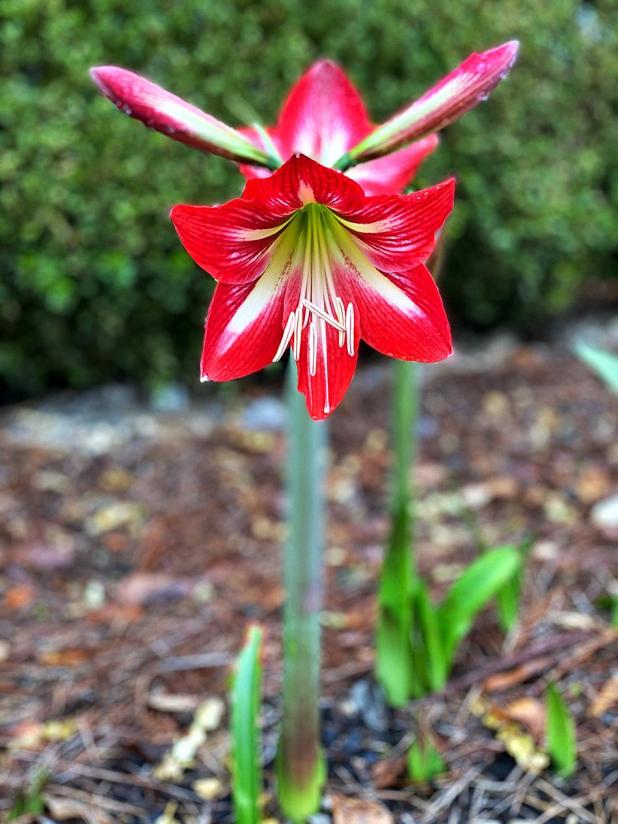
Amaryllis flowers come in colors of pink, red and white and combinations of these. Bulbs can be passed down to friends and family.
—LSU AgCenter/Heather Kirk-Ballard
Get It Growing: Landscapes spring to life
It’s that time of year. The deciduous trees are putting on their leaves. The oaks and pines are producing copious amounts of pollen. Live oaks are shedding leaves to put on new growth. Spring-blooming bulbs, trees and shrubs are starting to come to life.
Along with these early cues of winter breaking are some of the first signs of spring — the flowers. Bulbs such as amaryllis, crocus (corm), daffodils, paper whites and tulips are now blooming. Early-blooming shrubs and trees include azaleas, bridal wreath (spirea), ever-blooming roses, forsythia, Japanese magnolias, redbud trees, Taiwan cherry and viburnum.
Many of us are familiar with traditional flowering plants like azaleas, ever-blooming roses, Japanese magnolias and tulips. Let’s focus on some of the lesser-known early spring flowering plants.
Amaryllis is one of the earliest blooming bulbs. Flowers come in colors of red, pink and combinations of red and white. Due to the colors and early bloom time, amaryllis is a common Christmas flower.
Each bulb produces one or two leafless stems that each display a cluster of two or more funnel-shaped flowers at their tops. They look very much like lilies. Bulbs are native to Africa and grow well in U.S. Department of Agriculture plant hardiness zones 6 to 8. Plants produce several broad, strap-like green leaves that are arranged in rows.
In my family, amaryllis bulbs have been passed down for generations: our great-grandmothers, grandmothers, mothers and on to us daughters. We will continue the tradition of passing down bulbs to our daughters. Every year when the amaryllis blooms, I am reminded of all the beautiful women who carried on this lovely tradition. It’s amazing that our plants echo our generational progeny.
Bridal wreath (Spiraea prunifolia) is another early blooming plant. It is an open form, deciduous shrub that displays clusters of little white flowers. The sprays of dense white flowers cascade and flow downward, creating a unique look that attracts butterflies and other pollinators. In addition to being a beautiful focal point, these shrubs also can be used to create borders and hedges.
Use bridal wreath in combination with the bright colors of azaleas to create a striking landscape look. Shrubs are medium-sized and have a weeping, open form. They perform best in full sun and grow in hardiness zones 5 to 9.
Viburnum is another underused early spring flowering shrub. There are two noteworthy viburnums for Louisiana: Chinese snowball and Mrs. Schiller’s Delight. These both produce a gorgeous display of white flowers, much like bridal wreath. Chinese snowball makes gorgeous hydrangea-like blooms on semi-evergreen shrubs that grow to a height and width of 10 to 15 feet. They grow in hardiness zones 7 to 10 and do best in full sun to partial shade.
Another great viburnum is Mrs. Schiller’s Delight, which is a selection in the LSU AgCenter Louisiana Super Plants program. A dwarf cultivar of Walter’s viburnum, it displays an abundance of small, white flowers on a compact shrub. They are a low-maintenance, drought-tolerant shrub with small, narrow, glossy leaves that grow in opposite directions, giving this shrub its dense form. Typically for two to three weeks in late February to mid-March, Mrs. Schiller’s Delight will cover itself with clusters of white flowers. Mrs. Schiller’s can be used as a low-growing shrub for foundation plantings or in masses as the middle or foreground plant.
Redbud trees are another stunning early-blooming spring plant. Redbuds are very adaptable and easy to maintain once established. It is important to select a well-drained soil with average moisture. Plant redbuds in partial sun to shady locations. Full sun and full shade are not as good. The flowers come in pink, purple and fuchsia colors. Forest Pansy is a popular variety.
This year, we have already seen Japanese magnolias blooming. Azaleas, bridal wreath, ever-blooming roses and redbuds are already in bloom.
Spring has come early. The changing seasons vary with each year, and the climate trends appear to have shifted. Our latest frost maps for Louisiana have bumped their dates up by roughly two to three weeks.
In south Louisiana, the threat of the last freeze used to be considered as March 15, and in north Louisiana, April 1. However, new maps from the Southern Regional Climate Center and the National Centers for Environmental Infor-mation have moved these dates up. In south Louisiana, the last freeze can now be expected as early as mid- to late February, and in north Louisiana, in mid- to late March.
Cool-season vegetable plants had a shorter season this year, and we can now begin planting warm-season vegetables. This means we will have a longer season for our warm-season vegetables and an extended summer. Get out there and enjoy! It’s time to take the garden gloves and tools out of the shed and get to work.
